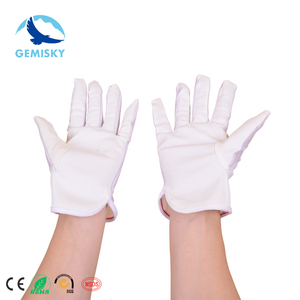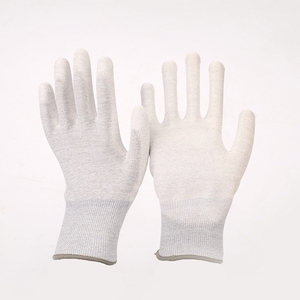(343 products available)






























































































































































































































Static gloves are essential in protecting the human body from the dangers of electrostatic discharge. Such gloves serve as an insulating medium between the human body and sensitive electronic devices and components.
The palm fit ESD gloves are classified based on the materials used in their construction, as well as the type of operation for which they are intended.
Static-resistance coated gloves rank among the most popular and are commonly used in electronics manufacturing. These gloves are usually coated with nitrile or latex at the palms and fingers to enhance grip and dexterity for operations in limited spaces. Such gloves are ideal for users who are likely to come into contact with slick and smooth electronic components.
These types of ESD gloves are made from thin ESD glove material, which is a combination of latex and ESD nylon, and are designed for short-term use. Semi-disposable gloves have a limited lifespan, Tthey must be changed frequently and constantly during their usage. They are, therefore, economical since they provide protection against ESD. Semi-disposable ESD gloves also offer good mechanical strength and impact resistance.
Full-finger ESD gloves cover the hand completely to provide protection against electrostatic discharge. They are mostly made of fine-gauge nylon and carbon fiber, thus ensuring high sensitivity in their texture for activities that require high dexterity and touch. Full-finger gloves are used in the semiconductor industry and precision manufacturing.
Half-finger ESD gloves protect electrostatic discharge and allow the fingers to remain free for tasks that need fine motor skills. These gloves are also known as fingerless ESD gloves. They are constructed from lightweight, flexible materials that provide effective control and dexterity. Half-finger gloves are mainly used in assembly work or when tasks require touch precision.
ESD wrist strap may also be applied to exposed fingers to protect sensitive electronic and small components. ESD finger cots are made from static dissipative materials. They are also effective in protecting electrostatic discharge. They are compact and easy to use, offering ESD protection while allowing the fingers to retain flexibility and mobility.
Due to their effective ESD protection, palm ESD gloves are useful in the electronic and semiconductor industries. These gloves are effective at resisting electrostatic discharge and avoiding damage to sensitive components by dissipating electrostatic charges from the human body.
In most cases, ESD palm gloves are a perfect fit for the palm. This is because they employ a more versatile design and are made of elastic or flexible materials. Such a design enables movement with comfort and better dexterity when performing delicate operations.
The glove's performance and durability are affected by temperature and humidity, especially in cleanroom environments and manufacturing areas with restricted climates. Therefore, palm ESD gloves are made from various breathable materials that regulate temperature on the palm and back of the hand. This helps keep users comfortable.
Durable ESD palm gloves are specifically designed to withstand wear and tear associated with industrial activities. Most palm ESD gloves are coated with nylon, nitrile, or polyurethane. These coatings increase the durability and abrasion resistance of the gloves, thus keeping them for a long period.
Due to their great degree of flexibility and thin materials, palm fit ESD gloves enhance dexterity in users. This feature allows workers to have a good sense of touch when performing tasks that involve intricate and complicated electronic components.
Glove palm ESDs help prevent the occurrences of ESD events that can seriously damage electronic products in manufacturing and handling environments. Companies avoid costly repairs and replacements by reducing ESD incidents.
In the long run, using ESD gloves translates to better overall quality products. These gloves reduce the number of defects in electronic components. This way, companies maintain higher quality products and avoid defective products that are costly to fix or reproduce.
Just as important, palm ESD gloves protect workers themselves. Although the prime purpose of these gloves is to protect sensitive components from electrostatic discharge, the gloves also shield the workers from high voltage discharge. This is crucial in industries that manage high voltages and sensitive components.
In most industries, including electronics, there are stringent requirements that must be complied with to provide safety and quality. Palm ESD gloves ensure compliance with these industry standards and statutory requirements. It reduces the risk of penalties, fines, or legal complications while meeting statutory safety standards.
By reducing ESD occurrences and associated damage, ESD gloves increase operational efficiency. They allow seamless operations and, therefore, fewer interruptions in production. As a result, commercial activities become more efficient because they are no longer interrupted by damage and downtime.
Material
Choosing ESD palm gloves requires careful consideration of materials. Most ESD gloves are made of nylon, with carbon or metal fibers woven into them for effective electrostatic dissipation. Latex, PU or nitrile coated models are available for better grip, dexterity, and durability of the palm. Furthermore, the materials should be breathable, stretchy and lightweight to ensure comfort in cleanroom or electronic assembly settings.
Size and Fit
Proper sizing is very important to put the palm fitting ESD gloves in place. It is only when the gloves fit properly that they will provide the necessary dexterity and touch sensitivity when handling delicate components. It is also important to ensure that the gloves have an elastic or stretchy material. That way, the gloves will fit tightly on all users and across different hand shapes and sizes.
ESD Properties
As for the palm ESD glove properties, business buyers must focus on their surface resistivity range. The surface resistivity should ideally be in the range of 10^6 to 10^9 ohms for most applications. Such a range will enable the gloves to dissipate static charges effectively without generating excess heat.
Comfort and Breathability
In environments where ESD gloves are worn for long-hour use, it is important to consider their level of comfort and breathability. As discussed, breathable materials such as nylon allow air circulation to keep the hands cool and dry during work. In addition, they must be lightweight and flexible, allowing easy movements to ensure there is no strain on the hands' muscles.
Industries and Applications
There are many types of palm ESD gloves appropriate for different jobs in various industries. ESD gloves without fingers are typically used in electronics assembly and semiconductor industries that require a high degree of touch sensitivity. At the same time, ESD gloves with palm coatings are handy in situations that require enhanced grip and dexterity. Understanding the target sector's unique needs will help select the right kind of glove for clients.
A.1: To take good care of palm ESD gloves, remember to wash them daily. This is because dust can accumulate on ESD gloves, which, when not cleaned daily, will result in contamination of sensitive components. Secondly, the ESD gloves may lose their electrostatic dissipation properties when exposed to harsh chemicals. When cleaning, users should use mild detergents in water.
A.2: ESD gloves should be replaced as soon as there are visible signs of wear, such as holes, fraying, or a loss of elasticity. Very often, the sandwiched materials used to manufacture these gloves undergo degradation over time. This also reduces their effectiveness in dissipating static charges. In this case, the gloves should be replaced once they show signs of wear and tear.
A.3: The primary function of palm ESD gloves in an industrial setting is to stop electrostatic discharge. They guard the human body's electrostatic charges to prevent them from transferring to sensitive electronic components. This way, they reduce the risk of static-induced damage during handling or assembly of the product.
A.4: Unlike other safety gloves, these gloves are designed primarily for electrostatic discharge. However, they provide a certain level of protection against minor cuts, abrasions, and skin contact with sharp objects. Therefore, it's not advised to wear solely rely on ESD gloves in environments where there is potential exposure to intense puncture or cuts. For that reason, other protective equipment is needed.
A.5: Palm ESD gloves are made of conductive carbon fiber and nylon blend materials. The nylon provides a strong and elastic structure, while carbon fibers efficiently dissipate electrostatic charges. This combination ensures that the gloves are long-lasting. It also enables them to function effectively in ESD-sensitive environments, such as clean rooms and electronics manufacturing facilities.